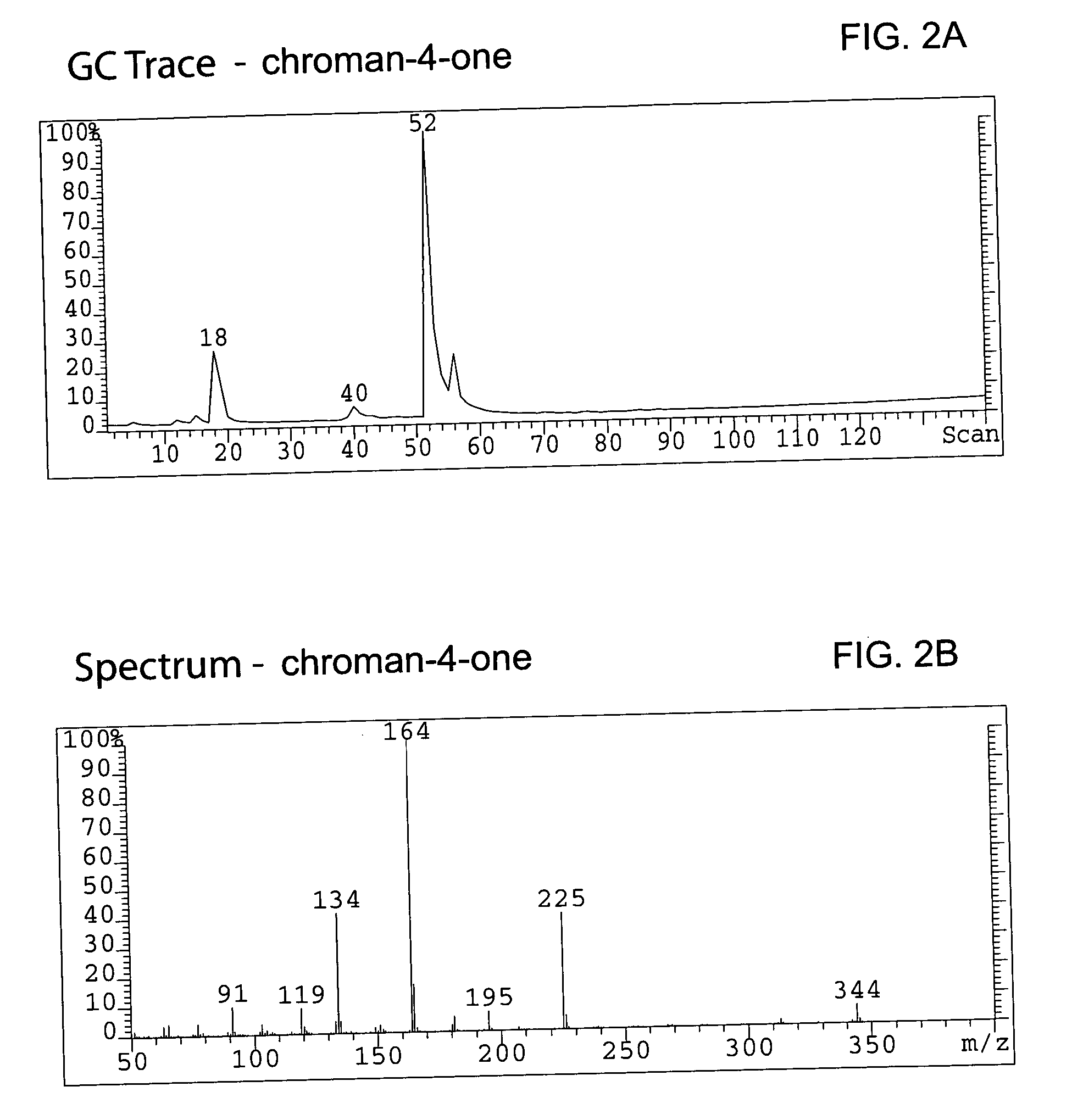Method for enantioselective hydrogenation of chromenes
a technology of enantioselective hydrogenation and chromenes, applied in the field of enantioselective hydrogenation of chromenes, can solve the problems of certain production rate limitations of the approach and unsuitable for commercial production, and achieve the effect of reducing the chroman-4-on
- Summary
- Abstract
- Description
- Claims
- Application Information
AI Technical Summary
Benefits of technology
Problems solved by technology
Method used
Image
Examples
example 1
Synthesis of the MOM-protected chromen-one (bis-MOM Daidzein, 7-methoxymethoxy-3-(4′-methoxymethoxy-phenyl)-2H-chromen-4-one)
[0080] A total of 329 g (1.29 mol) of 97% daidzein (from LLC Laboratories) was mixed with 4.5 L of dichloromethane in a 12 L 4-neck round bottom flask equipped with a thermocouple, overhead stirrer, heating mantle, addition funnel and nitrogen line. The resulted white suspension was chilled to 8° C., and a total of 655.8 g (5.07 mol, 3.9 eq.) of diisopropylethylamine (DIEA) was added to the pot. After 20 min a total of 373 g (4.63 mol, 3.59 eq.) of chloromethylmethyl ether (MOM-Cl) was added to the mixture via an addition funnel at 8° C. An ice bath was removed, replaced with a heating mantle and allowed to warm up to room temperature within 2 hours. The pot temperature was maintained at 40° C. and reaction was kept (usually overnight) at this temperature until daidzein and mono-MOM intermediate disappeared according to TLC (Rf=0.23 for daidzein, 0.38 for mon...
example 2
Hydrogenating the chromen-one to a chroman-one (7-methoxymethoxy-3-(4′-methoxymethoxy-phenyl) chroman-4-one)
[0085] A total of 336.5 g (0.983 mol) of bis-MOM-daidzein and 3.3 L of methanol were charged in a 12 L 4-neck round bottom flask equipped with a condenser, thermocouple, overhead stirrer, heating mantle and nitrogen line. A solid ammonium formate (309.4 g, 4.906 mol, 5 eq.) was added to the flask under agitation and a resulting slurry stirred for 20 min at room temperature. A total of 23.2 g (6.89 wt %) of dry 10%Pd / C was carefully transferred to the pot under nitrogen atmosphere and the reaction temperature was maintained at 45° C. The reaction was monitored by TLC (Rf=0.22 for bis-MOM-daidzein and 0.29 for the product in EtOAc / hexane=2:8) until all starting material disappeared (usually it requires 5 hours). Warm (˜30° C.) reaction mixture was filtered through Celite (142 g) in order to remove the catalyst, and the filter was washed with 2 L of dichlorometane. Organic filtr...
example 3
Reducing the chroman-one to a chroman-ol (7-methoxymethoxy-3-(4′-methoxymethoxy-phenyl) chroman-4-ol) as a mixture of cis- and trans-isomers
[0090] A total of 25.33 g (0.67 mol) of solid sodium borohydride was charged in a 12 L 4-neck round bottom flask equipped with a thermocouple, overhead stirrer, cooling ice / methanol bath, addition funnel and nitrogen line. A total of 3 L of dry THF was added to the flask and resultant suspension was cooled to 1.4° C. The glacial acetic acid (52.54 g, 0.875 mol) was slowly added to the flask as a solution in 200 mL of THF, and the mixture stirred at 10° C. for 20 min. The reaction was cooled to −4° C. and a solution of 230.1 g (0.668 mol) of bis-chroman-4-one in 1.3 L of THF was added to the flask. The reaction slowly agitated for three days at room temperature and monitored by TLC until all starting ketone disappeared. The reaction was quenched by addition to 12 L of cold saturated solution of ammonium chloride, organic layer was separated, and...
PUM
| Property | Measurement | Unit |
|---|---|---|
| temperature | aaaaa | aaaaa |
| enantiomeric excess | aaaaa | aaaaa |
| enantiomeric excess | aaaaa | aaaaa |
Abstract
Description
Claims
Application Information
 Login to View More
Login to View More - R&D
- Intellectual Property
- Life Sciences
- Materials
- Tech Scout
- Unparalleled Data Quality
- Higher Quality Content
- 60% Fewer Hallucinations
Browse by: Latest US Patents, China's latest patents, Technical Efficacy Thesaurus, Application Domain, Technology Topic, Popular Technical Reports.
© 2025 PatSnap. All rights reserved.Legal|Privacy policy|Modern Slavery Act Transparency Statement|Sitemap|About US| Contact US: help@patsnap.com



